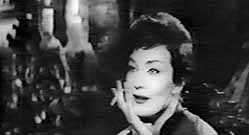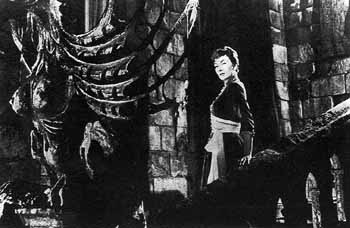|

The killer (Paul Muller) slips into a dressing room.
However, the movie is severely hampered by the weak central character--a smug, martinet of a newspaperman named Pierre La Salle who insists (without any evidence whatsoever) that a vampire is responsible for the murders that shock Paris: "I Say It's A Vampire!" scream the newspaper headlines. He struts up to the detectives at a crime scene: "Good morning. I thought you might need me here," he says with a smirk. "I thought that you could use a little talent and assistance." After only a few minutes, you'll be hoping the "vampires" get hold of him. (A police detective later tells him: "You're nothing but a sensation monger. As a newspaperman, you're a disgrace." But the events will prove La Salle to be on the right track.) Compensating for the annoying presence of Dario Michaelis as La Salle, the movie gives us magnificent sets, atmospheric cinematography, and several strong supporting performances.

Newspaperman Pierre La Salle (Dario Michaelis)
and the Paris police grill the killer (Paul Muller).
The story itself gives us a recent murder spree in Paris. Several strippers (the dubbing labels them "ballerinas" in the English language version!) have been drained of blood and dumped in the Seine. Now, a newspaperman, La Salle (Michaelis), claims a vampire is responsible. He's obsessed with catching the killer: "No one's scooped me yet and no one'll scoop me now." His co-worker says, "You're thinking so much of vampires it's driving you nuts." But La Salle doesn't hear him. He's shaking his head, his eyes out of focus: "I'm gonna get him . . . maniac!" Meanwhile, the camera shows us the killer (Paul Muller) at work, sneaking into dressing rooms and bathrooms and grabbing women. He isn't just killing women randomly. A doctor, Professor Julien du Grand (Antonie Balpetre) urges him to kill in exchange for injections of an unspecified drug. (In a scene deleted from the movie at the request of Italian censors, the killer is executed by guillotine. And then the doctor retrieves the head, places it on another body, and brings the killer back to life. You can still see the suture wounds on the killer's neck if you look closely.) However, the doctor is actually in cahoots with the Duchess du Grand, who herself still moons for her dead lover--the father of Pierre La Salle. The Doctor provides her with blood transfusions that reinvigorate her (she's actually over 100 years old) and allow her to masquerade as her own granddaughter, Giselle du Grand (Gianna Maria Canale). Once reinvigorated she caresses her face and looks at herself in a mirror: "There, there. I am beautiful!". But La Salle isn't interested in Giselle: "We had our romance and we had to break it up," he says with an uppity air. "Personal complications." But Giselle is obsessed with love: "I murder girls to be young. Murder anybody whose blood I can use so I'm not dried out. And all for love--love for Pierre and his father!"

Giselle (Gianna Maria Canale) revels in her
restored beauty: "There, there. I am beautiful!"
This strange combination of plot elements and characters doesn't always work well together. We don't get any characters that we can really care about. And the movie seems to be always pulling in ten different directions at the same time. We don't get to see enough of Canale as Giselle. In fact she only appears briefly until the movie is over halfway over. (Canale is a marvelous presence; dark and mysterious, she was a beauty queen in the late '40s and eventually married director Riccardo Freda.) We know virtually nothing about Pierre's girlfriend (played by Wandisa Guida)--until she's kidnapped and held captive by the Doctor and his clubfooted assistant. But the movie contains a stylish, dazzling mise-en-scene thanks to the work of director Riccardo Freda and cinematographer Mario Bava. These two names would soon become inextricably tied to Italian cinema.
Riccardo Freda had been involved in the Italian film industry since 1937, as both a screenwriter and production assistant. He made his debut as a director in 1942 with Don Cesare di Bazan and his career prior to I Vampiri included Les Miserables (1947) and several historical dramas. Freda was never particularly interested in the horror genre. He disliked making movies about the supernatural. He found the evil within normal men and women to be much more horrific than ghosts and monsters. Maybe that's why I Vampiri is so plausible. It isn't a movie about ordinary vampires. In fact, it doesn't give us any conventional vampires at all. Instead, it gives us a situation where a doctor (who works for the Institute of Experimental Surgery!) lusts to create artificial blood: he believes it's "the key to more and more power . . . they'll all bow to me!"
After running into troubles with the producers, Freda left the final two days of filming to Bava. As a result, Mario Bava's contributions go far beyond simply the camera angles and lighting. His presence is felt in the decrepit, decaying atmosphere of the Du Grand castle, where the crumbling stone walls and dusty passageways reflect the decadence of the Du Grands. He gives us low angle shots with stark shadows that creep up walls, hands that grab at balustrades, and rats that burrow into decaying corpses. Bava also devised a fascinating lighting effect for the blood transfusion scene: without the use of special makeup or time lapse photography, the Duchess becomes reinvigorated as the new blood enters her veins-- her hair darkens and her wrinkles disappear.
Both Freda and Bava would both go on to create better movies than I Vampiri. Much of I Vampiri's fame rests on its historical importance. The movie itself is slightly disappointing. The drama seems disjointed and the big scenes rushed. But for fans of the genre, it's fascinating evidence of the birth of Italian gothic horror.
Italian Horror Menu page
Italian Horror: A Brief Introduction
Mario Bava: The Illusion of Reality
Mario Bava's Rabid Dogs
Mario Bava Biography
The Horrible Dr. Hichcock
The Devil's Commandment 
Castle of Blood 
Nightmare Castle
The Bloody Pit of Horror 
Italian Horror in the Seventies
Suspiria
Italian Horror Web Links
Photo credits: Sinister Cinema.
| 





